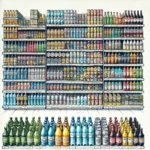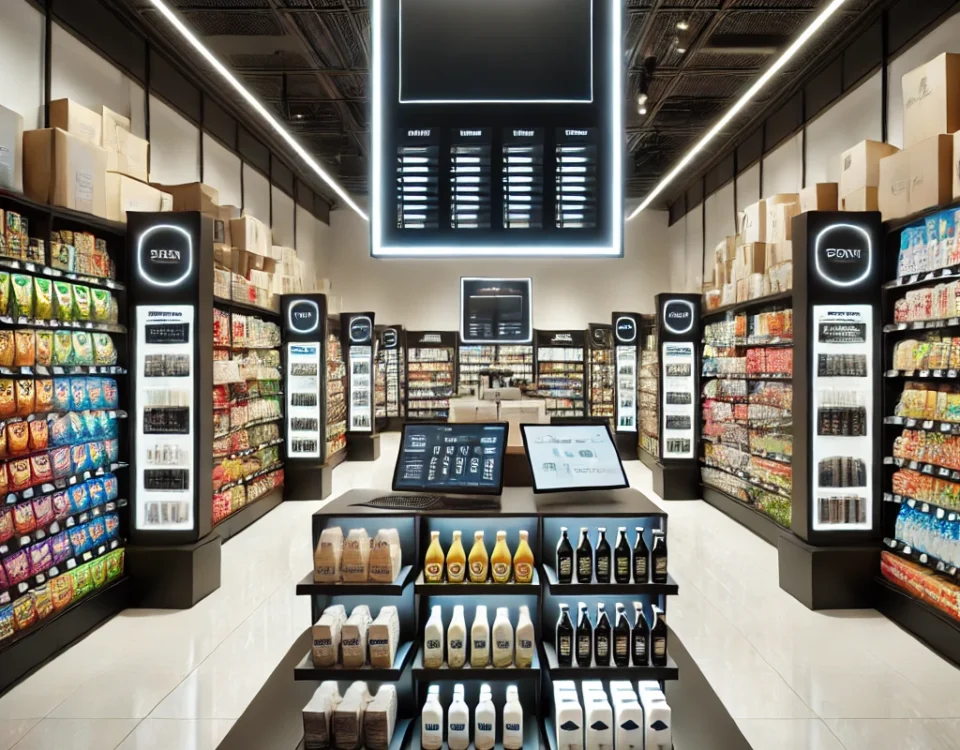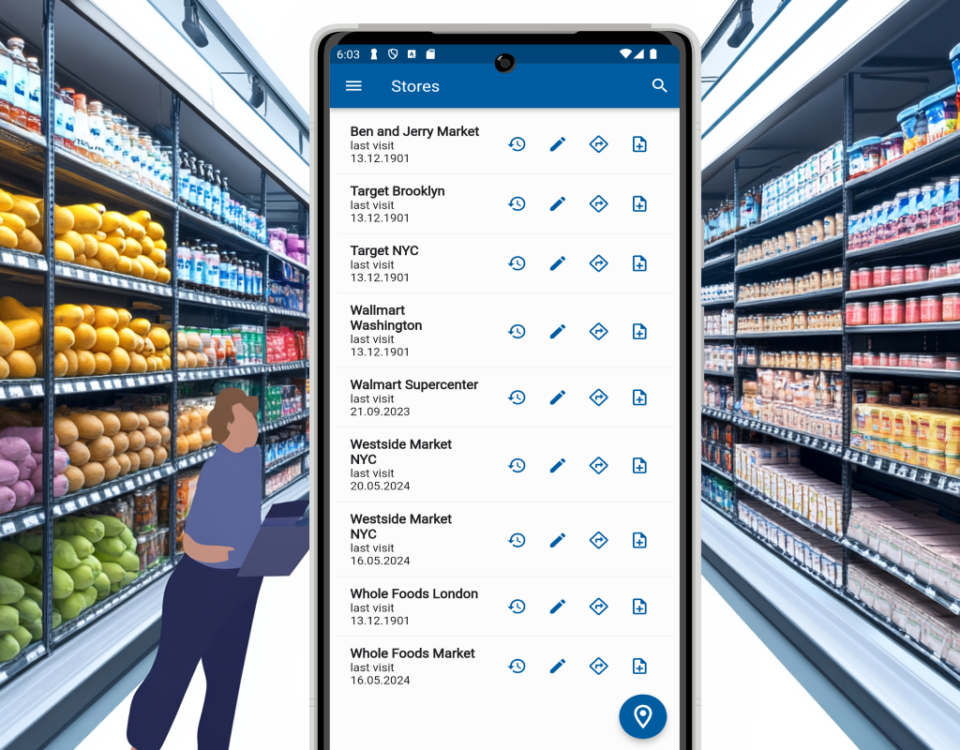
Merchandising: what it is and how it is used in retail

Planograms and their role in merchandising
What is the role of the merchandiser and why is it key to successful sales?
Merchandising is a key concept in retailing that aims to increase sales through the proper presentation of products in stores. It involves the strategic placement of goods so that they are as attractive and accessible to consumers as possible. Merchandisers are professionals who play a crucial role in this process, ensuring that products are arranged and presented in a way that stimulates spontaneous purchases and meets customer expectations. Their job is not only to ensure visual appeal, but also to monitor the availability and quality of the goods, thus contributing to the successful realisation of commercial objectives.
Contents
History and development of merchandising
Merchandising as a profession emerged in the United States in the 1930s, when retail was beginning to boom. The American Marketing Association first defined the term as “the planned promotion of the right product in the right place at the right price”. Over time, merchandising became an essential part of retail strategies, with the aim of optimising the in-store customer experience and driving sales.
Today, the profession is an integral part of successful marketing, with merchandisers playing a key role in presenting products in an attractive and strategic manner. The main objectives of merchandising in modern commerce include optimizing product displays, stimulating impulse purchases, and ensuring a constant availability of merchandise that attracts customers and increases sales. Advances in technology have also led to innovations in merchandising, such as the use of specialized software for better coordination and efficiency.
Main duties of the merchandiser
The merchandiser performs a number of critical tasks that ensure the successful presentation and sale of products in retail outlets. These duties include:
- Routing of outlets and daily control: merchandisers visit outlets daily to check the condition of goods, arrangement and stock. They ensure that products are displayed correctly and attractively to customers.
- Monitoring deliveries and keeping goods in optimal condition: one of their main commitments is to ensure the correct delivery of goods, checking their quality, packaging and shelf life. This ensures that no damaged or expired products end up on the shelves, which could lead to a negative impression on customers.
- Store logistics and space management: merchandisers organise space in stores, deciding how to use shelves and displays most effectively to maximise product visibility. They balance the need to use space efficiently with the attractiveness of the arrangement to customers.
- Implementation of planograms and display of goods on shelves: merchandisers follow certain planograms that dictate how products should be placed on shelves. They make sure that the goods are arranged according to marketing strategies to attract customer attention and increase the chances of a sale. This also includes ensuring that products are placed in strategic positions, such as eye level, to be easily spotted by shoppers.
Division of merchandisers
Depending on the specifics of their work, merchandisers can be divided into two main categories:
- Stationary merchandisers: these professionals work in a specific retail outlet, responsible for the maintenance and arrangement of products throughout the store or in specific departments. They have a detailed knowledge of the specifics of the particular site and work closely with the on-site team to ensure optimal merchandise presentation and maximum sales.
- Guest merchandisers: these merchandisers work in several different sites, often in different areas. They need to be mobile and organized to be able to perform their duties effectively in different stores. Guest merchandisers adapt to the varying demands of each outlet and often have to manage their time and logistics with precision to ensure consistent quality performance across the board.
The importance of the correct arrangement of goods
Proper positioning of products in the retail outlet plays a critical role in maximizing the use of retail space and increasing sales. When products are arranged logically and attractively, they not only attract customer attention, but also facilitate the purchase decision-making process. Good arrangement can encourage spontaneous purchases by making products more accessible and visible.
How proper product positioning affects sales
Research shows that products located at eye level are more likely to be noticed and purchased. This is due to the fact that consumers usually look around the shelves in search of the goods they need at the level they are most comfortable with. Products that are positioned at the end of shelves (known as ‘endcap’ areas) also have an advantage as these locations are usually more noticeable and are considered ‘premium’ items.
In addition, grouping related products can stimulate cross-selling. For example, placing sauces next to pasta or batteries next to electronic devices increases the likelihood that customers will purchase additional products they might not have otherwise considered.
Examples of effective merchandise stacking and display techniques
- Planograms: the use of planograms (detailed visual diagrams of product layouts) helps merchandisers create layouts that best meet customer expectations and brand marketing strategies. Planograms provide consistency in product arrangement, leading to better customer orientation in store.
- Product islands: product islands (specially designed structures in the store that attract attention) are effective for promotional campaigns and new products. They create a focal point that is easily noticeable and can encourage the purchase of products that would otherwise be overlooked.
- Lighting accents and colour schemes: the use of appropriate lighting and colour contrasts can greatly enhance the visual appeal of products. Light can accentuate certain products, while harmonious colour schemes create a pleasant atmosphere that encourages purchases.
- Dynamic Displays and Seasonal Arrangements: Periodically changing the arrangement depending on the season or special events keeps customers interested and entices them to browse and purchase new or trending products. This also helps retail outlets to be flexible and adaptable to market conditions.
By applying these techniques, merchandisers can create an environment that not only makes it easier for customers to find the products they need, but also encourages larger and more frequent purchases. Proper merchandising is an important factor in increasing sales and achieving long-term success in the trade.
Personal qualities and skills of a successful merchandiser
A successful merchandiser must possess a specific set of personal qualities and skills that are essential to effectively perform this dynamic and demanding role.
- Physical stamina and attention to detail: merchandisers often work on their feet all day, which requires good physical fitness. In addition, they must have a sharp eye for detail to ensure that merchandise is arranged perfectly and according to established standards.
- Sociability, focus and stress resilience: merchandisers work in an environment that requires constant communication with colleagues, managers and customers. They need to be sociable and goal-oriented in order to achieve set objectives. Stress resilience is equally important as the job often involves pressure to perform quickly and deal with unexpected situations.
- Need for knowledge in marketing, sociology and psychology: merchandisers need to understand the basics of marketing in order to apply best practices in product placement and presentation. Knowledge in sociology and psychology is also important as it helps merchandisers understand consumer behaviour and how to influence their buying decisions.
These qualities and skills are key to the successful implementation of merchandisers and the effective management of retail spaces, leading to increased sales and customer satisfaction.
Training and career development
Opportunities to enter the profession without a university degree: merchandising is one of the few professions where you can start without a university degree. Many companies offer on-the-job training, which allows new employees to quickly get into the job and learn the necessary skills.
How training and practice lead to career progression: Through a combination of training and practice, merchandisers can develop their sales and marketing skills. The constant accumulation of experience and knowledge allows employees to progress in their careers, becoming more effective and valuable to their employers.
Transition from merchandiser to other roles in the trade: With time and experience, merchandisers may transition to other roles in the trade, such as sales representatives or sales managers. These positions offer more responsibilities and opportunities for advancement, often involving team management, strategic planning and even developing marketing strategies. Merchandisers who rise in their careers become valuable leaders capable of contributing significantly to the success of the company.
Sample day of the merchandiser
A typical work day for a merchandiser starts early in the morning with a tour of the outlets he is responsible for. The first task is checking the condition of the goods – arranging the shelves, checking the expiry dates and the visual appeal of the products. The merchandiser then communicates with store managers to discuss the need for new supplies or promotions.
An important part of the day is maintaining good relationships with colleagues and customers. Informal contacts play a key role in successful task performance – sharing information and advice with colleagues, as well as building trust with store managers, makes the job easier and helps achieve better results.
At the end of the day, the merchandiser usually prepares reports on the work done, analyzes the results and plans the next day’s tasks, which also includes communicating with the team and management for feedback and coordination of activities.
Challenges and opportunities in the profession
Challenges and opportunities in the profession
Working as a merchandiser is dynamic and challenging, involving dealing with a variety of difficulties. One of the main difficulties is the physical workload, as merchandisers often spend long hours on their feet arranging goods and managing space in stores. In addition, the need to adapt quickly to different conditions in different outlets and communicate with a variety of customers and managers can also be stressful.
Despite these challenges, the profession offers significant opportunities. Good product presentation can significantly increase sales and contribute to the success of the company. When products are arranged in an attractive and logical way, they become more easily accessible and attractive to customers, which stimulates purchases. Effective product display and the use of the right marketing techniques can lead to a significant increase in sales, which in turn enhances the company’s reputation and ensures customer satisfaction. For merchandisers, this success can open doors to career advancement and greater opportunities for professional development.
How Movemar makes merchandisers’ jobs easier
Task automation: Movemar greatly facilitates the daily duties of merchandisers by automating processes such as planogram review, stock tracking and shelf monitoring. This reduces the time required for manual operations and improves efficiency.
Timely brand reporting and analytics: Movemar provides real-time information to the back office, giving supervisors detailed reporting and the ability to quickly evaluate merchandiser performance. This enables informed decision making and optimization of field activities.
Facilitated communication: Movemar facilitates communication between different teams and site managers, improving coordination and ensuring better task completion. This helps to exchange information more quickly and accurately, which is key to operational success.
Mobility: Movemar is accessible on mobile devices, allowing merchandisers to manage and execute their tasks directly from the field. This gives them the ability to react to changing circumstances in real-time and be more flexible in their work, regardless of their location.
Conclusion
The merchandiser is a key factor in the success of any sales strategy. By properly arranging and displaying merchandise, merchandisers not only increase product visibility, but also drive sales, which directly contributes to achieving sales goals. Merchandising has a profound impact on commerce, and its effective application requires professional development and ongoing training.
Using software like Movemar greatly facilitates this process by automating tasks, providing timely reporting and improving communication. This makes merchandisers’ jobs more efficient and contributes to better results for the company.




